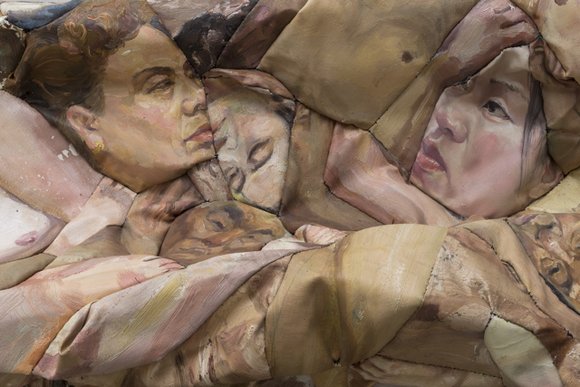
Hu Qingyan, The Falling Flesh, 2015; Oil on canvas, 210x75x90cm
Sculpture is the most daring and audacious of all expressive media; it begins by deconstructing something that already exists as a unique presence in nature in order to construct a mental projection that exists in the mind of the artist first, and then in the most fortunate cases, in the mind of the viewer. However, it is nevertheless destined to be a fragment lost in time and space struggling to return to that initial unity. The work of Hu Qingyan (b. 1982 in Weifang, Shandong Province, China, lives and works in Beijing), presented in 空殼 Hollow Husk, his most recent solo exhibition, is far from what we traditionally conceive as sculpture, but it is a reflection on the language of sculpture when considered as space at large, and on how sculpture and space, in and out—entities that are often deemed complementary—interact with each other, nurturing and inspiring each other. The artist takes on a peculiar yet risky task; he makes his gestures as unobtrusive as possible and reduces his volition to a minimum, perhaps because he regards them as a sort of disturbing, unnecessary force exerted on something that already exists in its primordial, ideal shape and that just needs the right conditions to come to life.
The diverse and varied pieces on view perfectly reflect the multiple trajectories taken by Hu Qingyan’s working ethos over the last few years; the planned, calculated element often gives way to the unplanned, to a sort of extemporization contingent upon the materials employed and their intrinsic value, rather than the uniqueness of the manual gesture and of the conceptual input provided by the artist (Seven-Character Quatrain 3 and Seven-Character Poem (2015 and 2016, rebar, 28 resp. 56 pcs., sizes vary from 15 x 9 x 4 cm to 69 x 23 x 10 cm)).
The genesis of the works in the series Go in One Ear and Out the Other (2016, carbon steel, air) or Nothing but You Can Put at Home (2016, carbon steel, car paint) epitomize this practice. In Go in One Ear and Out the Other, the outline of the system of carbon steel tubes diameter reductions is firstly defined by the found material employed and secondly by the hand of the artist’s assistant who was responsible for defining everything including the size of the work. The artist’s input was to decide at what point the evolving shape should be considered a “final” one; however, the term “final” should not be read as “fixed,” because the obtained shape is just one of the steps in the series of metamorphoses that shapes and spaces can undergo, crystallized in time by pure chance. This approach is not new to Hu, because he has also used it in the ongoing series Narrative by a Pile of Clay (2013-2015, c-prints, different sets of 40 photos, each 20 x 30 cm), a work on which the artist has worked since 2013. It perfectly reflects the paradox dominating a sculptor’s life, which is caught in the incessant yet necessary balancing of the acts of construction and deconstruction. Nothing but You Can Put at Home pushes the line even further; the physical found object that the artist has painted becomes a pretext for raising questions that investigate the semantics of art-making and the identity of the art maker himself.Painting and The Falling Flesh (2015, oil on canvas, 223 x 120 x 90 cm) subtly yet ironically investigate the essence of painting and sculpture by playing visual tricks on the viewer, through what may be a painting disguised as a sculpture (a sculptural painting) or a sculpture disguised as a painting (a painterly sculpture), both painted and sculpted by chance.
Apparently totemic pieces like Idiots No. 2 (2016, carbon steel, air, 7 pcs, height from 79 cm to 188 cm) and Airhead No. 2 (2016, carbon steel, air, 53 x 252 x 53 cm) turn out to be exactly what their titles suggest: remnants, hollow husks, hollow vessels deprived of any specific function other than being air containers about to be processed or informed once again. They have no aura or majesty other than that of being living, expanding organisms; this is because of the internal circulation of air, not what the artist’s hand has created,? a mere shell whose signs of assemblage are still visible. This prompts the viewer to think, or at least doubt, that the real sculpture is not the exterior, but what is invisible and being “shaped” inside the shells.
About the artist
Hu Qingyan was born in 1982 in Weifang, Shandong Province, China and studied sculpture at the Guangzhou Academy of Fine Arts in Guangzhou and the Central Academy of Fine Arts in Beijing. He lives and works in Beijing and Jinan. A selection of his most recent exhibitions includes: Shut up and paint, National Gallery of Vitoria, Melbourne, Australia (2016); The Exhibition of Annual of Contemporary Art of China, Beijing Minsheng Art Museum, Beijing, China (2016); M + Sigg Collection: Four Decades of Chinese Contemporary Art, ArtisTree, Hong Kong, China (2016); Familiar Otherness: Art Across Northeast Asia, Hong Kong Arts Center, Hong Kong, China (2015); 28 Chinese, Rubell Family Collection/ Contemporary Arts Foundation, Miami, USA (2013); 中 (Middle), Not Vital Foundation, Ardez, Switzerland (2013); Building Bridges – Zeitgen?ssische Kunst aus China, Wolfsberg, Ermatingen, Switzerland (2013); Starting – Youth Artists Introducing Plan by China Sculpture Institute, Today Art Museum/China Sculpture Institute, Beijing, China (2012).
Text: Manuela Lietti
About the exhibition
Dates: November 18, 2016 - January 28, 2017
Opening: Friday, November 18, 2016; 6 - 8pm
Courtesy of the artist and Galerie Urs Meile, for further information please visit https://galerieursmeile.com.




























